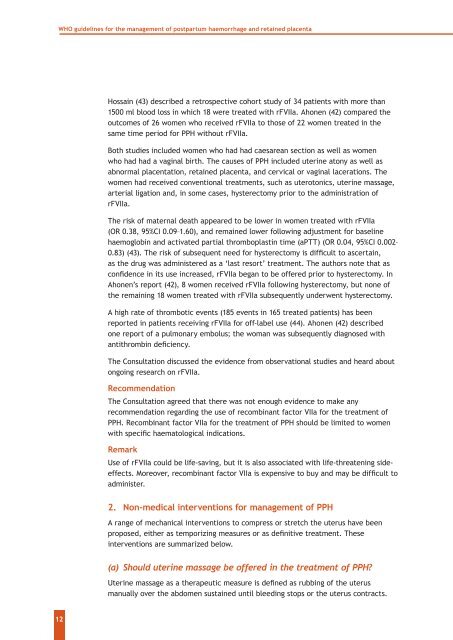WHO guidelines for the management of postpartum haemorrhage ...
WHO guidelines for the management of postpartum haemorrhage ...
WHO guidelines for the management of postpartum haemorrhage ...
Create successful ePaper yourself
Turn your PDF publications into a flip-book with our unique Google optimized e-Paper software.
<strong>WHO</strong> <strong>guidelines</strong> <strong>for</strong> <strong>the</strong> <strong>management</strong> <strong>of</strong> <strong>postpartum</strong> <strong>haemorrhage</strong> and retained placenta<br />
Hossain (43) described a retrospective cohort study <strong>of</strong> 34 patients with more than<br />
1500 ml blood loss in which 18 were treated with rFVIIa. Ahonen (42) compared <strong>the</strong><br />
outcomes <strong>of</strong> 26 women who received rFVIIa to those <strong>of</strong> 22 women treated in <strong>the</strong><br />
same time period <strong>for</strong> PPH without rFVIIa.<br />
Both studies included women who had had caesarean section as well as women<br />
who had had a vaginal birth. The causes <strong>of</strong> PPH included uterine atony as well as<br />
abnormal placentation, retained placenta, and cervical or vaginal lacerations. The<br />
women had received conventional treatments, such as uterotonics, uterine massage,<br />
arterial ligation and, in some cases, hysterectomy prior to <strong>the</strong> administration <strong>of</strong><br />
rFVIIa.<br />
The risk <strong>of</strong> maternal death appeared to be lower in women treated with rFVIIa<br />
(OR 0.38, 95%CI 0.09–1.60), and remained lower following adjustment <strong>for</strong> baseline<br />
haemoglobin and activated partial thromboplastin time (aPTT) (OR 0.04, 95%CI 0.002–<br />
0.83) (43). The risk <strong>of</strong> subsequent need <strong>for</strong> hysterectomy is difficult to ascertain,<br />
as <strong>the</strong> drug was administered as a ‘last resort’ treatment. The authors note that as<br />
confidence in its use increased, rFVIIa began to be <strong>of</strong>fered prior to hysterectomy. In<br />
Ahonen’s report (42), 8 women received rFVIIa following hysterectomy, but none <strong>of</strong><br />
<strong>the</strong> remaining 18 women treated with rFVIIa subsequently underwent hysterectomy.<br />
A high rate <strong>of</strong> thrombotic events (185 events in 165 treated patients) has been<br />
reported in patients receiving rFVIIa <strong>for</strong> <strong>of</strong>f-label use (44). Ahonen (42) described<br />
one report <strong>of</strong> a pulmonary embolus; <strong>the</strong> woman was subsequently diagnosed with<br />
antithrombin deficiency.<br />
The Consultation discussed <strong>the</strong> evidence from observational studies and heard about<br />
ongoing research on rFVIIa.<br />
Recommendation<br />
The Consultation agreed that <strong>the</strong>re was not enough evidence to make any<br />
recommendation regarding <strong>the</strong> use <strong>of</strong> recombinant factor VIIa <strong>for</strong> <strong>the</strong> treatment <strong>of</strong><br />
PPH. Recombinant factor VIIa <strong>for</strong> <strong>the</strong> treatment <strong>of</strong> PPH should be limited to women<br />
with specific haematological indications.<br />
Remark<br />
Use <strong>of</strong> rFVIIa could be life-saving, but it is also associated with life-threatening sideeffects.<br />
Moreover, recombinant factor VIIa is expensive to buy and may be difficult to<br />
administer.<br />
2. Non-medical interventions <strong>for</strong> <strong>management</strong> <strong>of</strong> PPH<br />
A range <strong>of</strong> mechanical interventions to compress or stretch <strong>the</strong> uterus have been<br />
proposed, ei<strong>the</strong>r as temporizing measures or as definitive treatment. These<br />
interventions are summarized below.<br />
(a) Should uterine massage be <strong>of</strong>fered in <strong>the</strong> treatment <strong>of</strong> PPH?<br />
Uterine massage as a <strong>the</strong>rapeutic measure is defined as rubbing <strong>of</strong> <strong>the</strong> uterus<br />
manually over <strong>the</strong> abdomen sustained until bleeding stops or <strong>the</strong> uterus contracts.<br />
12
















